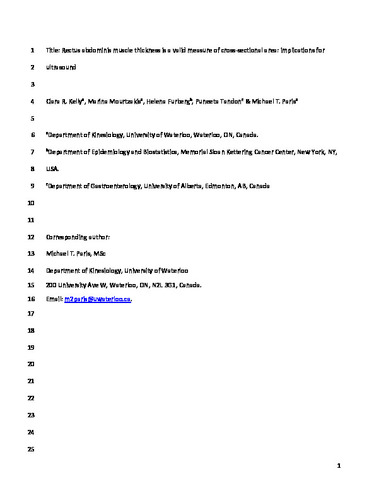| dc.contributor.author | Kelly, Ciara | |
| dc.contributor.author | Mourtzakis, Marina | |
| dc.contributor.author | Furberg Barnes, Helena | |
| dc.contributor.author | Tandon, Puneeta | |
| dc.contributor.author | Paris, Michael | |
| dc.date.accessioned | 2023-05-10 14:09:19 (GMT) | |
| dc.date.available | 2023-05-10 14:09:19 (GMT) | |
| dc.date.issued | 2022-03 | |
| dc.identifier.uri | https://doi.org/10.1016/j.acra.2021.06.005 | |
| dc.identifier.uri | http://hdl.handle.net/10012/19435 | |
| dc.description | The final publication is available at Elsevier via https://doi.org/10.1016/j.acra.2021.06.005. © 2022. This manuscript version is made available under the CC-BY-NC-ND 4.0 license http://creativecommons.org/licenses/by-nc-nd/4.0/ | en |
| dc.description.abstract | Rationale and objectives: The rectus abdominis muscle exhibits early and significant muscle atrophy, which has largely been characterized using ultrasound measured muscle thickness. However, the validity of rectus abdominis muscle thickness as a metric of muscle size has not been established, limiting precise interpretation of age-related changes. In a heterogeneous cohort of women and men, our objectives were to: (1) evaluate the association between rectus abdominis muscle thickness and cross-sectional area (CSA), and (2) examine if the visceral adipose tissue (VAT) compartment confounds the validity of rectus abdominis muscle thickness.
Materials and methods: Abdominal computed tomography scans of the third lumbar vertebrae from clinical and healthy populations were used to evaluate rectus abdominis thickness and CSA, and VAT CSA. Computed tomography scans were utilized due to the limited field of view of ultrasound imaging to capture the rectus abdominis CSA.
Results: A total of 348 individuals (31% women) were included in this analysis, with a mean ± standard deviation age and body mass index of 51.2 ± 15.4 years and 28.0 ± 5.1 kg/m2, respectively. Significant correlations were observed between rectus abdominis thickness and CSA for women (r = 0.758; p < 0.001) and men (r = 0.688; p < 0.001). Independent of age, VAT CSA was negatively associated with rectus abdominis thickness in men (p = 0.011), but not women (p = 0.446).
Conclusion: These data support the use of rectus abdominis muscle thickness as a measurement of muscle size in both women and men; however, the VAT compartment may confound its validity to a minor extent in men. | en |
| dc.language.iso | en | en |
| dc.publisher | Elsevier | en |
| dc.relation.ispartofseries | Academic Radiology; | |
| dc.subject | muscle thickness | en |
| dc.subject | computed tomography | en |
| dc.subject | body composition | en |
| dc.title | Rectus abdominis muscle thickness is a valid measure of cross-sectional area: implications for ultrasound | en |
| dc.type | Article | en |
| dcterms.bibliographicCitation | Kelly, C. R., Mourtzakis, M., Furberg, H., Tandon, P., & Paris, M. T. (2022). Rectus abdominis muscle thickness is a valid measure of cross-sectional area: Implications for ultrasound. Academic Radiology, 29(3), 382–387. https://doi.org/10.1016/j.acra.2021.06.005 | en |
| uws.contributor.affiliation1 | Faculty of Health | en |
| uws.contributor.affiliation2 | Kinesiology and Health Sciences | en |
| uws.typeOfResource | Text | en |
| uws.peerReviewStatus | Reviewed | en |
| uws.scholarLevel | Faculty | en |

